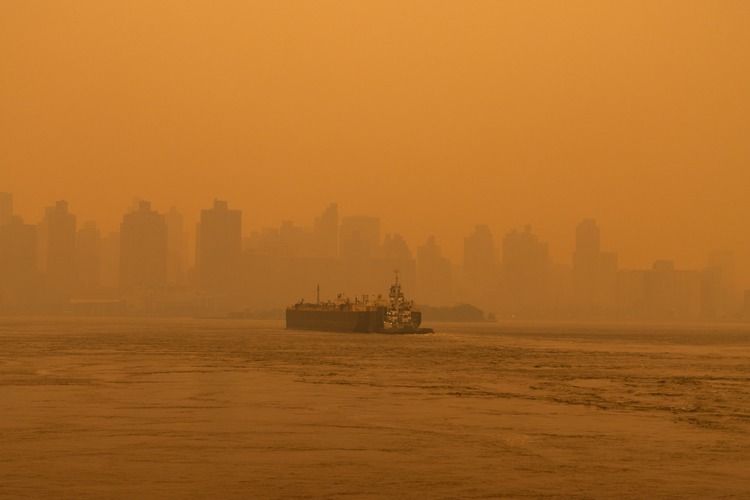
More than 400 wildfires in Canada lead to dangerously smoky conditions in several provinces, diminishing air quality across northern USA
by Victoria Heath
Smoke from intense wildfires in Canada has now spread across to the USA, causing millions to be advised to wear N95 masks outdoors across North America, with flights delayed at major airports in New York and Washington DC, and zoos bringing animals indoors.
On Wednesday, The National Oceanic and Atmospheric Administration (NOAA) said one of its satellites showed some of the smoke from the Canadian wildfires being ‘swept up’ by a large swirling low-pressure system.
Wildfires continue to burn through millions of acres of Canada, and more than 248 fires are out of control, according to the Canadian Interagency Forest Fire Center (CIFFC). In Quebec alone, 150 fires are burning.
The wildfires have already displaced 20,000 people in Canada, and Canadian officials are asking other countries to help in the fight to tackle more than 400 wildfires.
On Tuesday, Canada’s capital city, Ottawa, faced an air quality index of above 10 – classified as ‘very high risk’ according to Environment Canada. Air quality risk is measured on a scale from 1-10 in Canada, and has since dropped to 6 – ‘moderate risk’ – as of yesterday afternoon. However, Toronto’s air quality is expected to worsen today to 9, deemed ‘high risk’.

The impact of Canada wildfires on the USA
Across the USA, at least 13 states have been issued with air quality alerts in places, affecting an estimated 115 million people.
As of late Wednesday night, into early Thursday morning, Philadelphia had the worst air quality of any major city in the world, with a figure of 447.
From today, New York will start distributing free masks, as the city’s skyline and the landmark Statue of Liberty are obscured by orange haze. Broadway shows in New York City were cancelled and an indoor WNBA game in Brooklyn postponed yesterday evening due to poor air quality.
Air quality index, a metric by the U.S Environmental Protection Agency, is defined as good at a level under 50; over 300 is considered ‘hazardous’. At times in Syracuse, New York City and Lehigh Valley, Pennsylvania, the figure surpassed 400.
‘This is an unprecedented event in our city, and New Yorkers must take precautions,’ Adams said. ‘At the moment, we recommend vulnerable New Yorkers stay inside, and all New Yorkers should limit outdoor activity to the greatest extent possible.’
Effects of wildfire smoke on health
The fine particulates within wildfire smoke are known to be harmful during sustained exposure, causing eye, throat and sinus irritation. Wildfire particulates can be especially harmful to vulnerable groups, such as older people, those who are pregnant and people with existing lung and heart conditions.
‘On these elevated air pollution days, we’ll see an increased number of visits to hospital,’ Matthew Adams, a professor at the University of Toronto and the director of its Centre of Urban Environments, said. ‘And the people that are visiting the hospital typically have a pre-existing respiratory disease.’

What is causing the Canadian wildfires?
Home to some of the densest forests in the world, Canada experiences wildfires each year. But these latest fires are much worse than normal. Across Canada, the fires have burned 9.4 million acres of land, 12 times the 10-year-average for this time of year.
Normally, half of Canada’s wildfires occur due to lightning, and the other half are caused by human activity, such as starting an open fire or leaving a burning cigarette on the ground. Wildfires occur more frequently when the air is hot and ground is dry – meaning that climate change also contributes to wildfires by worsening drought conditions through prolonged hot weather.
These drought conditions and continual hot temperature forecasts mean Canada is bracing itself for ‘higher-than-normal’ fire activity across the wildfire season, which typically spans from April to September.



